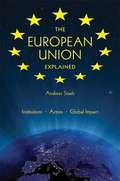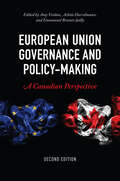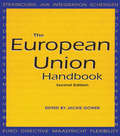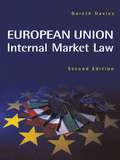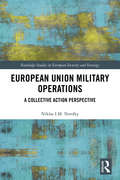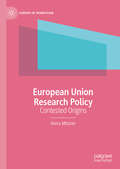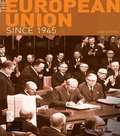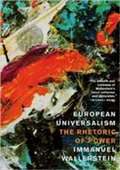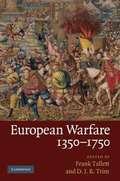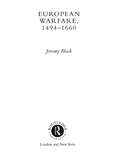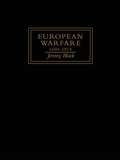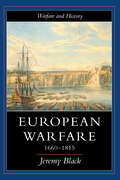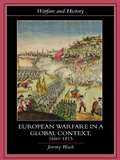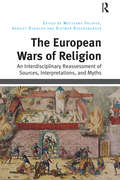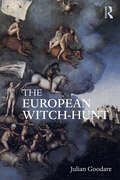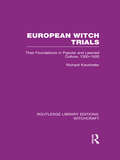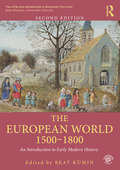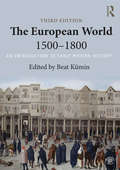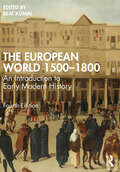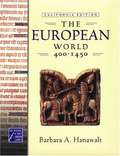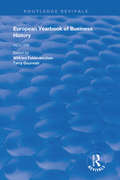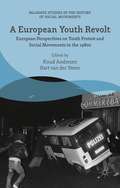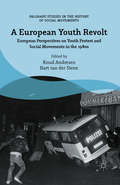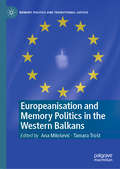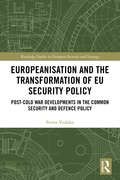- Table View
- List View
The European Union Explained: Institutions, Actors, Global Impact
by Andreas StaabThe European Union Explained provides a concise overview of the structure, history, and policies of the European Union. Anyone who needs a quick and accessible introduction to the EU - including scholars and professionals in government, business, media, or the non-profit sector - will find this volume a valuable tool. Ideal for advanced high school and college text use, it is also useful background reading for those planning overseas study, work, or research. Drawing on many years of teaching and consulting, Andreas Staab offers basic terms and interpretive frameworks for understanding the evolution of the EU; the overall structure, purpose, and mandate of its main constituent divisions; and key policy areas, such as market unification. Andreas Staab is founder and director of the European Policy Information Centre (EPIC), a London-based training agency on the European Union. He is author of National Identity in Eastern Germany as well as articles on citizenship, democracy, and European politics.
European Union Governance and Policy-Making, Second Edition: A Canadian Perspective
by Amy Verdun Achim Hurrelmann Emmanuel Brunet-JaillyEuropean Union Governance and Policy-Making introduces the politics of the European Union (EU) to a student audience. The book is explicitly written for students enrolled in universities in Canada, or other non-EU countries, and builds on their academic background. Chapters cover the political and legal system of the EU, theories of European integration, core EU policies such as the Single Market, its single currency, migration policy, EU enlargement, as well as pressing issues facing the further development of European integration. This second edition has been comprehensively revised and updated to include a discussion of Brexit, the European Green Deal, COVID-19, and the Russian invasion of Ukraine. Written by leading Canadian scholars in the field of European integration, as well as international experts with teaching experience in Canadian universities, this textbook leverages the comparison to Canada and its federal system to help students understand what is unique about the European Union.
The European Union Handbook (Regional Handbooks of Economic Development)
by Ian ThomsonThe new edition of this praised resource features 29 essays grouped under six main headings: History and Context; Politics; Economics; Law and Society; International Relations; and the Future. Each essay is written by a specialist contributor who has also provided a further reading list with annotations. Useful supporting material in the form of charts, maps, tables, and relevant texts completes each chapter.
European Union Internal Market
by Gareth DaviesFirst published in 2003. Routledge is an imprint of Taylor & Francis, an informa company.
European Union Military Operations: A Collective Action Perspective (Routledge Studies in European Security and Strategy)
by Niklas I. NovákyThis book offers an in-depth study on the deployment of military operations in the framework of the European Union’s Common Security and Defence Policy (ESDP/CSDP). While existing studies of the subject are either descriptive or focused on a single level of analysis, this book incorporates factors from three different levels of analysis to explain the deployment of ESDP military operations. First, the international level, where the emergence of events that threaten certain values held dear by EU member states, catalyses the process leading to an operation; second, the national level, where the member states formulate their initial national preferences towards a prospective deployment based on national utility expectations; and third, the EU level, where the member states come to negotiate and seek compromises to accommodate their different national preferences towards a deployment. The strength of this multi-level collective action approach is demonstrated by four in-depth military case studies, which analyse the preference formation of France, Germany, and the UK towards the deployments of Operation Althea in Bosnia and Herzegovina, Operation Artemis and EUFOR RD Congo in the Democratic Republic of the Congo (DRC), and Operation Atalanta off the coast of Somalia, respectively. The author draws on a wealth of primary sources, including over 50 semi-structured interviews conducted with national and EU officials during 2011-15, and provides an up-to-date overview and critique of the existing theoretical literature on the deployment of ESDP/CSDP military operations. This book will be of much interest to students of European security, EU politics, military and strategic studies, and International Relations in general.
European Union Research Policy: Contested Origins (Europe in Transition: The NYU European Studies Series)
by Veera MitznerThis book describes the emergence of research policy as a key competence of the European Union (EU). It shows how the European Community (EC, the predecessor of the EU), which initially had very limited legal competence in the field, progressively developed a solid policy framework presenting science and research as indispensable tools for European economic competitiveness and growth. In the late 20th century Western Europe, hungry for growth, concerned about the American technological lead, and keen to compete in the increasingly open international markets, the argument for a joint European effort in science and technology seemed plausible. However, the EC was building its new functions in an already crowded field of European research collaboration and in a shifting political context marked by austerity, national rivalries, new societal and environmental challenges, and emerging ambivalence about science. This book conveys the contested history of one of the EU’s most successful policies. It is a story of struggle and frustration but also of a great institutional and intellectual continuity. The ideational edifice for the EC/EU research policy that was put in place during the 1960s and 1970s years proved remarkably robust. Its durability enabled the rapid takeoff of the European Commission’s initiatives in the more favorable political atmosphere of the early 1980s and the subsequent expansion of the EU research funding instruments and programs that permanently transformed the European research landscape.
The European Union Since 1945 (Seminar Studies)
by Alasdair BlairThe European Union faces a crossroads in the twenty-first century. While there is evidence of declining enthusiasm for European integration, the EU plays an increasingly vital role in tackling problems that can no longer be dealt with at member state level. In recent years, the EU has developed a stronger foreign, security and defence policy, and has had to face up to the challenges of tackling organised crime, human trafficking and drug smuggling. In this fully updated new edition, Alasdair Blair examines the economic, political, social and personal factors that have shaped the process of European integration from the end of the Second World War until the Lisbon Treaty in 2009. Written in a clear and jargon-free style, the book explores: The context of European integration and expansion The relations between the European Union and its member states The institutional evolution of the European Union Methods of decision-making Key policies of the European Union The future direction of the European Union Comprehensive and accessible, this book is an essential guide to understanding the relevance of the European Union in the twenty-first century.
European Universalism: The Rhetoric of Power
by Immanuel WallersteinAt a time when intervention - in the name of democracy and human rights - has returned to the center of world politics, Wallterstein's treatise is both essential and convincing.
European Warfare, 1350-1750
by Frank Tallett D. J. B. TrimThe period 1350-1750 saw major developments in European warfare, which not only had a huge impact on the way wars were fought, but also are critical to long-standing controversies about state development, the global ascendancy of the West, and the nature of 'military revolutions' past and present. However, the military history of this period is usually written from either medieval or early-modern, and either Western or Eastern European, perspectives. These chronological and geographical limits have produced substantial confusion about how the conduct of war changed. The essays in this book provide a comprehensive overview of land and sea warfare across Europe throughout this period of momentous political, religious, technological, intellectual and military change. Written by leading experts in their fields, they not only summarise existing scholarship, but also present new findings and new ideas, shedding new light on the art of war, the rise of the state, and European expansion.
European Warfare, 1494-1660 (Warfare and History)
by Jeremy BlackThe onset of the Italian Wars in 1494, subsequently seen as the onset of 'modern warfare', provides the starting point for this impressive survey of European Warfare in early modern Europe. Huge developments in the logistics of war combined with exploration and expansion meant interaction with extra-European forms of military might. Jeremy Black looks at technological aspects of war as well social and political developments and effects during this key period of military history. This sharp and compact analysis contextualises European developments and as establishes the global significance of events in Europe.
European Warfare, 1660-1815 (Warfare And History Ser.)
by Jeremy BlackThis is a history of warfare, wars and the armed forces of Europe from the military revolution of the mid-17th century to the Napoleonic wars.; This book is intended for broad-based undergrad courses on 18th century Europe/Britain and the Ancien Regime. 2nd and 3rd year thematic courses on warfare in the modern period, and students of war studies.
European Warfare, 1660-1815
by Professor Jeremy Black Jeremy BlackThis is a history of warfare, wars and the armed forces of Europe from the military revolution of the mid-17th century to the Napoleonic wars.; This book is intended for broad-based undergrad courses on 18th century Europe/Britain and the Ancien Regime. 2nd and 3rd year thematic courses on warfare in the modern period, and students of war studies.
European Warfare in a Global Context, 1660-1815 (Warfare and History)
by Jeremy BlackThis original book presents a global approach to eighteenth century warfare. Emphasis is placed on the importance of conflict in the period and the capacity for decisiveness in impact and development in method. Through this Jeremy Black extends the view beyond land to naval conflict. European Warfare in a Global Context offers a comparative approach, in the sense of considering Western developments alongside those elsewhere, furthermore it puts emphasis on conflict between Western and non-western powers. This approach necessarily reconsiders developments within the West, but also offers a shift in emphasis from standard narrative of the latter. This book is the ideal study of warfare for all students.
The European Wars of Religion: An Interdisciplinary Reassessment of Sources, Interpretations, and Myths
by Wolfgang Palaver Harriet Rudolph RegensburgerIn recent years religion has resurfaced amongst academics, in many ways replacing class as the key to understanding Europe's historical development. This has resulted in an explosion of studies revisiting issues of religious change, confessional violence and holy war during the early modern period. But the interpretation of the European wars of religion still remains largely defined by national boundaries, tied to specific processes of state building as well as nation building. In order to more thoroughly interrogate these concepts and assumptions, this volume focusses on terms repeatedly used and misused in public debates such as "religious violence" and "holy warfare" within the context of military conflicts commonly labelled "religious wars". The chapters not only focus on the role of religion, but also on the emerging state as a driver of the escalation of violence in the so-called age of religious war. By using different methodological and theoretical approaches historians, philosophers, and theologians engage in an interdisciplinary debate that contributes to a better understanding of the religio-political situation of early modern Europe and the interpretation of violent conflicts interpreted as religious conflicts today. By adopting a multi-disciplinary approach, new and innovative perspectives are opened up that question if in fact religion was a primary driving force behind these conflicts.
The European Witch-Hunt
by Julian GoodareThe European Witch-Hunt seeks to explain why thousands of people, mostly lower-class women, were deliberately tortured and killed in the name of religion and morality during three centuries of intermittent witch-hunting throughout Europe and North America. Combining perspectives from history, sociology, psychology and other disciplines, this book provides a comprehensive account of witch-hunting in early modern Europe. Julian Goodare sets out an original interpretation of witch-hunting as an episode of ideologically-driven persecution by the ‘godly state’ in the era of the Reformation and Counter-Reformation. Full weight is also given to the context of village social relationships, and there is a detailed analysis of gender issues. Witch-hunting was a legal operation, and the courts’ rationale for interrogation under torture is explained. Panicking local elites, rather than central governments, were at the forefront of witch-hunting. Further chapters explore folk beliefs about legendary witches, and intellectuals’ beliefs about a secret conspiracy of witches in league with the Devil. Witch-hunting eventually declined when the ideological pressure to combat the Devil’s allies slackened. A final chapter sets witch-hunting in the context of other episodes of modern persecution. This book is the ideal resource for students exploring the history of witch-hunting. Its level of detail and use of social theory also make it important for scholars and researchers.
European Witch Trials: Their Foundations in Popular and Learned Culture, 1300-1500 (Routledge Library Editions: Witchcraft)
by Richard KieckheferIn popular tradition witches were either practitioners of magic or people who were objectionable in some way, but for early European courts witches were heretics and worshippers of the Devil. This study concentrates on the period between 1300 and 1500 when ideas about witchcraft were being formed and witch-hunting was gathering momentum. It is concerned with distinguishing between the popular and learned ideas of witchcraft. The author has developed his own methodology for distinguishing popular from learned concepts, which provides adequate substantiation for the acceptance of some documents and the rejection of others. This distinction is followed by an analysis of the contents of folk tradition regarding witchcraft, the most basic feature of which is its emphasis on sorcery, including bodily harm, love magic, and weather magic, rather than diabolism. The author then shows how and why learned traditions became superimposed on popular notions – how people taken to court for sorcery were eventually convicted on the further charge of devil worship. The book ends with a description of the social context of witch accusations and witch trials.
The European World 1500–1800: An Introduction to Early Modern History
by Beat KüminThe European World 1500-1800 provides a concise and authoritative textbook for the centuries between the Renaissance and the French Revolution. It presents early modern Europe not as a mere transitional phase, but a dynamic period worth studying in its own right. Written by an experienced team of specialists, and derived from a perennially successful undergraduate course, it offers a student-friendly introduction to all major themes and processes of early modern history. Structured in four parts dealing with socio-economic, religious, cultural and political issues, it adopts a deliberately broad geographical perspective: Western and Central Europe receive particular attention, but dedicated chapters also explore the wider global context. For this thoroughly revised and improved second edition, the authors have added three new chapters on 'Politics and Government', 'Impact of War' and 'Revolution' Specially designed to assist learning, The European World 1500-1800 features: state-of-the-art surveys of key topics written by an international team of historians suggestions for seminar discussion and further reading extracts from primary sources and generous illustrations, including maps a glossary of key terms and concepts a chronology of major events a full index of persons, places and subjects a fully-featured companion website, enhanced for this new edition The European World 1500-1800 will be essential reading for all students embarking on the discovery of the early modern period.
The European World 1500–1800: An Introduction to Early Modern History
by Beat KüminThe European World 1500-1800 provides a concise and authoritative textbook for the centuries between the Renaissance and the French Revolution. It presents early modern Europe not as a mere transition phase, but a dynamic period worth studying in its own right. Written by an experienced team of specialists, and derived from a successful undergraduate course, it offers a student-friendly introduction to all major themes and processes of early modern history. This third edition features greatly expanded coverage of ‘The Wider World’, with added chapters on relations with the Ottoman empire, European settlement overseas and the global exchange of goods. Other new content includes an overview of early modern medicine and comprehensive timelines for each of the thematic parts. Specially designed to assist learning, The European World 1500-1800 features: expert surveys of key topics written by an international group of historians suggestions for seminar discussion and further reading extracts from primary sources and generous illustrations, including maps a glossary of key terms and concepts a full index of persons, places and subjects and a much enhanced companion website, offering colour images, direct access to primary materials, and interactive features which highlight key events and locations discussed in the volume. The European World 1500-1800 will be essential reading for all students embarking on the discovery of the early modern period.
The European World 1500–1800: An Introduction to Early Modern History
by Beat KüminThe European World 1500–1800 provides a concise and authoritative textbook for the centuries between the Renaissance and the French Revolution. It presents early modern Europe not as a mere transition phase, but a dynamic period worth studying in its own right. Written by an experienced team of specialists, and derived from a successful undergraduate course, it offers a student-friendly introduction to all major themes and processes of early modern history. This fully updated fourth edition is structured in six parts – Starting Points, Society and Economy, Religion, The Wider World, Culture, Politics – and includes two new chapters on the Environment and Food and Drink Cultures. Specially designed to assist learning, The European World 1500–1800 features: • expert surveys of key topics written by an international group of historians • suggestions for seminar discussion and further reading • extracts from primary sources and generous illustrations, including maps • a glossary of key terms and concepts • a full index of persons, places and subjects • and a companion website, offering colour images, direct access to primary materials, and interactive features which highlight key events and locations discussed in the volume. The European World 1500–1800 is essential reading for all students embarking on the discovery of the early modern period.
The European World, 400-1450 (The Medieval and Early Modern World #1)
by Barbara HanawaltAs the Roman Empire began to crumble and lose its long-held dominance over Europe, new civilizations were emerging to fill the void. Germanic tribes like the Goths, the Franks, and the Vandals, as well as the Huns and Visigoths all fought for control of the land. Christianity became a more acceptable religion throughout Europe, while the Islamic religion was born in the Middle East and quickly spread, eventually making its way into Europe. The blending and conflict of cultures and beliefs helped to create what we now call the Middle Ages. Fascinating new characters were also rising in Europe like the emperor and empress of the Byzantine Empire Justinian and Theodoraambitious leaders who made one final push to recapture the west and regain the past glory of the Roman Empire. Meanwhile in the west Charlemagne had come to power by crowning himself emperor. A popular leader he spent much of his time travelling through his land on horseback accompanied by an entourage that often included an elephant! Vikings from Scandinavia began raiding parts of Europe until eventually they were stopped by Alfred the king of Wessex in England. By 1066, however, the Scandinavians got their revenge when William the Conqueror invaded England and took over. Filled with intrigue, conflict, power struggles, and colorful characters and based on primary source materials Barbara Hanawalt's The European World is an adventure at every turn. From Attila the Hun to Joan of Arc, from the fall of Rome to the Plague this pivotal moment in history comes alive.
European Yearbook of Business History: Volume 1 (Routledge Revivals #1)
by Terry GourvishFirst published in 1998, The European Yearbook of Business History publishes research and review articles in English on the history of private enterprises based in individual European countries as well as studies of transnational corporations. It also includes work on public and state corporations. Its scope is all of Europe, not merely the countries of the European Union, and its prime, but not exclusive, period of interest is the 19th and 20th centuries. The first issue includes reviews of the present state and future prospects of business history in most European countries, together with articles summarising current Japanese and American perspectives on the history of European industrial and commercial enterprises.
A European Youth Revolt: European Perspectives on Youth Protest and Social Movements in the 1980s (Palgrave Studies in the History of Social Movements)
by Knud Andresen Bart van der SteenA European Youth Revolt.
A European Youth Revolt: European Perspectives on Youth Protest and Social Movements in the 1980s (Palgrave Studies in the History of Social Movements)
by Bart van der SteenDuring the early 1980s, large parts of Europe were swept with riots and youth revolts. Radicalised young people occupied buildings and clashed with the police in cities such as Zurich, Berlin and Amsterdam, while in Great Britain and France, 'migrant' youths protested fiercely against their underprivileged position and police brutality. Was there a link between the youth revolts in different European cities, and if so, how were they connected and how did they influence each other? These questions are central in this volume. This book covers case studies from countries in both Eastern and Western Europe and focuses not only on political movements such as squatting, but also on political subcultures such as punk, as well as the interaction between them. In doing so, it is the first historical collection with a transnational and interdisciplinary perspective on youth, youth revolts and social movements in the 1980s.
Europeanisation and Memory Politics in the Western Balkans (Memory Politics and Transitional Justice)
by Ana Milošević Tamara TroštThis volume explores how the process of European integration has influenced collective memory in the countries of the Western Balkans. In the region, there is still no shared understanding of the causes (and consequences) of the Yugoslav wars. The conflicts of the 1990s but also of WWII and its aftermath have created “ethnically confined” memory cultures. As such, divergent interpretations of history continue to trigger confrontations between neighboring countries and hinder the creation of a joint EU perspective. In this volume, the authors examine how these “memory wars” impact the European dimension - by becoming a tool to either support or oppose Europeanisation. The contributors focus on how and why memory is renegotiated, exhibited, adjusted, or ignored in the Europeanisation process.
Europeanisation and the Transformation of EU Security Policy: Post-Cold War Developments in the Common Security and Defence Policy (Routledge Studies in European Security and Strategy)
by Petros ViolakisThe aim of this study is to examine the extent to which the end of the Cold War led to Europeanisation in the Common Security and Defence Policy (CSDP). The analysis takes into consideration previous studies on Europeanisation and its impact on the transformation of national security and defence, and attempts to account for the development of Europeanisation and related mechanisms. These mechanisms, which have been described as framing mechanisms and negative integration, incorporate all the major relevant factors identified here (i.e. a common Strategic Culture, new security identity, domestic political decision-making, industrial base and defence-spending decline) that contributed to the realisation of the CSDP. The relevance of these factors for CSDP Europeanisation is examined through an historical and empirical analysis, and the relationship between the CSDP and North Atlantic Treaty Organization (NATO) is also explored. This approach facilitates analysis of the debate concerning the emergence of the CSDP and throws light on the political shift that led European Union (EU) leaders to support the CSDP. Another aspect of this study is the empirical examination of the dynamics and limitations of the European defence sector. The changes which took place in this sector facilitated the emergence of the CSDP and are therefore analysed in the light of globalisation issues, economies of scale, economic crises, military autonomy, new security strategy and Research and Development (R&D) impact. This book will be of interest to students of European security, EU politics, defence studies and International Relations.
